
- This paper will first discuss several examples of survey-based research into adolescent social media use, then will go on to …
- This paper first discusses several examples of survey-based research into adolescent social media use, then goes on to …
Are cows responsible for climate change? A recent study (RIVM, 2019) shows that cattle farmers account for two thirds of agricultural nitrogen emissions in the Netherlands. These emissions result from nitrogen in manure, which can degrade into ammonia and enter the atmosphere. The study’s calculations show that agriculture is the main source of nitrogen pollution, accounting for 46% of the country’s total emissions. By comparison, road traffic and households are responsible for 6.1% each, the industrial sector for 1%. While efforts are being made to mitigate these emissions, policymakers are reluctant to reckon with the scale of the problem. The approach presented here is a radical one, but commensurate with the issue. This paper argues that the Dutch government must stimulate and subsidize livestock farmers, especially cattle farmers, to transition to sustainable vegetable farming. It first establishes the inadequacy of current mitigation measures, then discusses the various advantages of the results proposed, and finally addresses potential objections to the plan on economic grounds.
- A hook to catch the reader’s interest
- Relevant background on the topic
- Details of your research problem
- A thesis statement or research question
- Sometimes an overview of the paper
The final part of the introduction is often dedicated to a brief overview of the rest of the paper.
Step 5: Map out your paper
The thesis statement expresses the position that the rest of the paper will present evidence and arguments for. It can be presented in one or two sentences, and should state your position clearly and directly, without providing specific arguments for it at this point.
The introduction looks slightly different depending on whether your paper presents the results of original empirical research or constructs an argument by engaging with a variety of sources.
The introduction to a research paper is where you set up your topic and approach for the reader. It has several key goals:
- Present your topic and get the reader interested
- Provide background or summarize existing research
- Position your own approach
- Detail your specific research problem
- Give an overview of the paper’s structure

Make a list of the matters you are interested in, conduct a research to see whether chosen variants have much credible data online. Cross out options, which can’t be backed with reliable sources or don’t stir up your interest.
A good introduction should lead the reader from a generalized topic to a particular aspect. It helps to establish the main idea, context, research importance and summarizes background data on the topic, providing the main goal of the work. In addition it contains hypothesis, a set of discussed questions and used methodology.
- Background information on the topic
The best way to get started if you lack information or ideas on writing an introduction is to learn about it online. Following tips of professional writers and tutors you will be able to create an outstanding work, which won’t leave anyone indifferent.
How to write an Introduction?

Research paper introduction can be one of the most difficult parts to complete. The size of this section depends on the work type you are asked to complete.
Following tips from AssignmentPay's expert team will help you to understand how a research paper introduction should look like and how to help readers enjoy your paper. In case you don’t have enough time or energy to write a research paper introduction, you can always pay for research paper - just contact and get outstanding assistance within a chosen period of time!
First paragraphs of your research paper give the audience information on quality of chosen arguments, your personal style, as well as on validity of conclusions. If your introduction is weak and lacks structure, it may make the reader want to put your research paper aside.

- This study set out to answer the following question: What effects does daily use of Instagram have on the prevalence of body image issues among adolescent girls?
- We investigated the effects of daily Instagram use on the prevalence of body image issues among adolescent girls.
If included, the overview should be concise, direct, and written in the present tense.
For example, the following could be an effective hook for an argumentative paper about the environmental impact of cattle farming:
The introduction looks slightly different depending on whether your paper presents the results of original empirical research or constructs an argument by engaging with a variety of sources.
Argumentative paper: Thesis statement
Present your research question clearly and directly, with a minimum of discussion at this point. The rest of the paper will be taken up with discussing and investigating this question
The way you present your research problem in your introduction varies depending on the nature of your research paper. A research paper that presents a sustained argument will usually encapsulate this argument in a thesis statement.
The five steps in this article will help you put together an effective introduction for either type of research paper.
A research question can be framed either directly or indirectly.
_1568118756-min_1614615284.jpg)
"Introductions need to be organized, succinct, and clear. Clear writing is essential when writing a research paper. Often, students work so hard in crafting an interesting hook that the rest of the introduction devolves into another direction. For students, I always recommend clearly identifying what your thesis is - what are you planning on focusing on for your paper? As a reader, do I know what the premise of the paper is before I continue reading? For research papers, engagement is in the pithiness of writing and the organizational structure. In introductions particularly, the statement of organization is vital. The statement of organization dictates how the rest of the paper will be structured and what the reader should look to when they are reading. For research papers, follow your passions. What interests you? What is a topic that keeps you up at night? What are you passionate about? Finding a topic that resonates with you is key when aiming to write ideas clearly."
Sana Shaikh, PhD, Director of School Operations in Springfield Public SchoolsThough introduction to any writing is frequently associated with beginning, it's not that simple for an introduction to a research paper. Here you can find a guide on how to write an introduction to a research paper, which presents a topic to the reader. While creating an introduction for a research paper students frequently get lost in the consistency of their thoughts. But following the structure and simple rules, you will succeed with your writing and get the desired mark..
An introduction is the initial part of a research paper and the part that a reader is likely to read first (at least when focusing deeply and reading your paper in detail). Hence, definitions, notions, and other information required for understanding the paper are presented/listed here.
"A strong introduction to a research paper should probably be written last. The introduction needs to include: 1) what the topic is focused on, 2) how the research was conducted(method), 3) what the findings are (generally), 4) and how the paper contributes to the overall field. These items are often unanswerable until the paper is complete. An introduction should also absolutely have a few sentences that specifically detail what they will read in the upcoming pages. Research Papers are NOT like fiction writing where you might want to sustain the mystery—instead,you want to show them the payoff up front. If the reader gets to the end of the introduction and does not know what to expect in the rest of the paper, you may have missed the mark."
Dr. Elizabeth M. Minei, PhD, Associate Professor at Baruch College, Founder and C.E.O. of EMinei ConsultingNeed more writing assistance?

The introduction of a research paper may contain a few other parts/ elements such as the chief goal(s) and objectives of the research, a brief but informative outline of the following content, explained, concept definitions, a brief history of the research into the topic, recent related discoveries, etc.).
Every research paper needs context so that readers can understand why you have created it. This is exactly what you can do in your research paper introduction. Of course, this can mean that your introduction is the hardest part of the paper to write first. So, it is essential that you take your time and make sure you get it right.
Writing a good intro requires matching well the information in it with the rest of the paper – it must “serve” the needs of the rest of the paper. It should introduce the reader smoothly into the topic and facilitate an easy read (without requiring the excessive aid of external sources).
:max_bytes(150000):strip_icc()/GettyImages-586158036-5aafc8f943a1030036589fad.jpg)
Search a journal database, such as PsychInfo or ERIC, to find articles on your subject. Once you have located an article, look at the reference section to locate other studies cited in the article. As you take notes from these articles, be sure to write down where you found the information.
Emily is a fact checker, editor, and writer who has expertise in psychology content.
The purpose of an introduction in a psychology paper is to justify the reasons for writing about your topic. Your goal in this section is to introduce the topic to the reader, provide an overview of previous research on the topic, and identify your own hypothesis.
Finding appropriate sources amid thousands of journal articles can be a daunting task, but there are several steps you can take to simplify your research. If you have completed the initial steps of researching and keeping detailed notes, writing your introduction will come much easier.
Start Your Psychology Paper Introduction by Researching Your Topic
Once you are ready to write your introduction, your first task is to provide a brief description of the research question. What is the experiment or study attempting to demonstrate? What phenomena are you studying? Provide a brief history of your topic and explain how it relates to your current research.
A simple note detailing the author's name, journal, and date of publication can help you keep track of sources and avoid plagiarism.
Once you have summarized the previous research, explain areas where the research is lacking or potentially flawed. What is missing from previous studies on your topic? What research questions have yet to be answered? Your hypothesis should lead to these questions.

To write a good hook, avoid overly broad statements or long, dense sentences. Try to start with something clear, concise and catchy that will spark your reader’s curiosity.
It’s especially important to make sure your thesis statement accurately represents what you do in the essay. If your argument has gone in a different direction than planned, tweak your thesis statement to match what you actually say.
A thesis statement is a sentence that sums up the central point of your paper or essay. Everything else you write should relate to this key idea.
For this reason, it’s often a good idea to wait until later in the writing process before you write the introduction paragraph—it can even be the very last thing you write.
More examples of essay introductions
A good introduction paragraph is an essential part of any academic essay. It sets up your argument and tells the reader what to expect.
- Catch your reader’s attention.
- Give background on your topic.
- Present your thesis—the central point of your essay.
The length of each part depends on the length and complexity of your essay.
You have a strong introduction - now make sure the rest of your essay is just as good.
